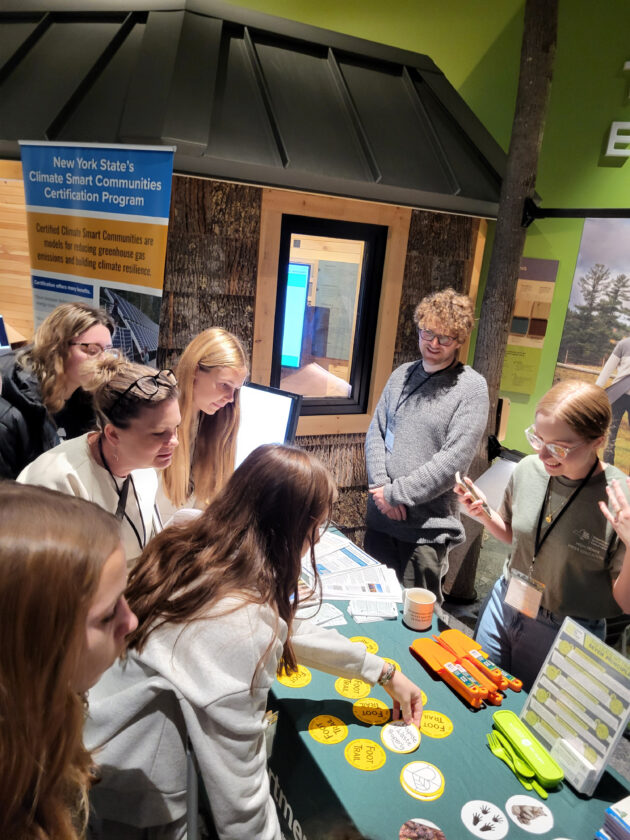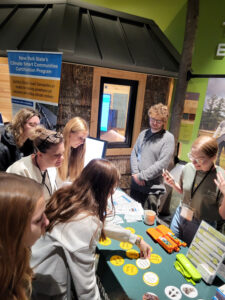Students convene at Wild Center youth climate summit

Youth Climate Summiteers engage in Leave No Trace memory game with Kendra Ormerod and Nicole Revai of the state Department of Environmental Conservation. (Provided photo)
TUPPER LAKE — Two weeks ago, heads of state, foreign ministers, senior diplomats and CEO’s from 140 countries around the globe (minus the United States) met in Belem, Brazil for the #COP30 United Nations climate summit at which leaders renewed their commitment to the 2015 Paris climate agreement in support of policies to hold average global temperature rise to below 2 degrees Celsius (and preferably closer to 1.5 degrees). At that same time, a cadre of 150 inspiring, ambitious and committed youth leaders from 23 schools from New York and Vermont convened at The Wild Center in Tupper Lake for their own highly productive Youth Climate Summit.
The annual Adirondack Youth Climate Summit, founded and pioneered by The Wild Center in 2009, has been a catalyst for Youth Climate Summits in 28 states and 11 countries. Now in its 15th year, the two-day, activity-packed conference planned by youth for youth brings together teens to learn from one another and empower each other to accelerate change toward a more sustainable future in their own lives, schools and communities.
Over the years, the Youth Climate Summit has evolved from an event planned for youth to an event planned by youth.
“The climate summits of the early years were heavily focused only on science and there wasn’t a diversity of thought and perspectives in the presentations,” The Wild Center Director of Climate Initiatives Jen Kretser said. “Now the summits are hands-on, student-led and there’s more ownership by the youth for the event. The summit has also become more interdisciplinary and solution-focused, and teens can participate where they are and bring their strengths and passion to the topic. Youth agency or the sense of your own power and your own ability to affect the future through your own internal qualities strengthened by actions, intentionality and self-generated choices, is very powerful.”
On the second day of the conference, youth climate “summiteers” visited exhibit tables in the “Community Climate Action Hub” to speak with presenters and engage in a range of topics. At the Better Choices exhibit table, teens interacted with an AI-driven app called FamiliesCuttingCosts.org that allowed students to calculate the carbon footprint and cost of their morning breakfast to better understand their impact and make personalized decisions toward carbon reduction. At the Paul Smith’s College exhibit table, teens donned a VR headset to enter an augmented reality experience to witness plant life changes in the local environment as temperatures of the Adirondack region steadily increase.
Representatives from Cornell University, Skidmore College and SUNY College of Environmental Science and Forestry were present to speak with youth summit participants about college programs in sustainability and environmental science. ESF highlighted their non-traditional curriculum for Rangers and “red card” fire training certification, with 50% of coursework offered outside in the field. Representatives from TRANE Technologies, a lead sponsor of this year’s Youth Climate Summit, showcased their industry credentials and certificates available for high school and college students, as well as HVAC trade workers in northern New York.
Several exhibit presentations featured curriculum resources for the 30 teachers who participated in the summit. Rachel Arbor, CEO & Founder of Gaia Scholastic, demonstrated examples of her company’s interdisciplinary K-12 environmental literacy and environmental STEAM programming with lesson plans blending state standards with real-world applications. Also exhibiting was SubjectToClimate, a global nonprofit that connects educators to high-quality, standards-aligned climate and sustainability resources at no cost to educators.
Sunny Edwards, a junior at Keene Central School, was asked what he appreciated most about the Youth Climate Summit.
“I had a lot of climate anxiety, so my mother suggested a summer job at the Wild Center. I got involved and attended the summer retreat, where I bonded with other students and helped plan this entire summit,” he said. “Adults need to take teenagers more seriously. Young people are a huge force in the climate movement, and we want to be taken into account when decisions are made — the Seven Generations idea.”
The Seven Generations idea is a principle and ethical framework for long-term sustainability rooted in the philosophy of the Indigenous Haudenosaunee (Iroquois) Confederacy that applies to decisions about the energy we use, water and natural resources and urges the current generations to ensure those decisions result in sustainable relationships that last at least seven generations into the future.
Jasper Surdo, a senior at Beekmantown High School, and a presenter for the Climate Action Planning workshop that concluded the summit, was the only student in attendance at the climate summit from his school of more than 500 students.
“I hope to create a Green Team at my school and introduce new ways to deal with compost for gardening,” he said. “Today’s youth care about climate issues and we’re knowledgeable, creative, qualified and have meaningful insights and solutions — adults shouldn’t disregard our input.”
The final activity of the summit was the Climate Action Planning workshop presented by youth leaders Surdo and Amelia Pratt, a student at Tupper Lake High School. Pratt is developing a project to build a greenhouse in her community. The two youth climate leaders presented a handbook of tools for students to identify attributes of change makers in their communities who are able to assist with their projects. The youth learned how to conduct community inventories or “Power Mapping” to better understand who will be influential in their project’s success and who will be impacted by their project and they also learned to conduct a root cause analysis to understand community needs and what effects and causes have been barriers to delivering a solution. More than 25 projects conceived by the students are in the planning stages from this year’s climate summit.
Lily Powers, a senior at Lake Placid High School, was asked about their climate activism.
“There isn’t only one way you can have a voice, you can speak through comedy, poetry, short stories, creativity …” she said. “There’s power and pride knowing that others are working toward this and I’m not alone; we’re learning together. I’ve gone from hopeless to hopeful.”


